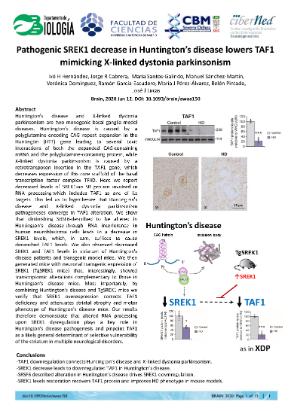
Huntington's disease and X-linked dystonia parkinsonism are two monogenic basal ganglia model diseases. Huntington's disease is caused by a polyglutamine-encoding CAG repeat expansion in the Huntingtin (HTT) gene leading to several toxic interactions of both the expanded CAG-containing mRNA and the polyglutamine-containing protein, while X-linked dystonia parkinsonism is caused by a retrotransposon insertion in the TAF1 gene, which decreases expression of this core scaffold of the basal transcription factor complex TFIID. Here we report decreased levels of SREK1-an SR protein involved in RNA processing-which includes TAF1 as one of its targets. This led us to hypothesize that Huntington's disease and X-linked dystonia parkinsonism pathogeneses converge in TAF1 alteration. We show that diminishing SRSF6-described to be altered in Huntington’s disease-through RNA interference in human neuroblastoma cells leads to a decrease in SREK1 levels, which, in turn, suffices to cause diminished TAF1 levels. We also observed decreased SREK1 and TAF1 levels in striatum of Huntington's disease patients and transgenic model mice. We then generated mice with neuronal transgenic expression of SREK1 (TgSREK1 mice) that, interestingly, showed transcriptomic alterations complementary to those in Huntington's disease mice. Most importantly, by combining Huntington's disease and TgSREK1 mice we verify that SREK1 overexpression corrects TAF1 deficiency and attenuates striatal atrophy and motor phenotype of Huntington's disease mice. Our results therefore demonstrate that altered RNA processing upon SREK1 dysregulation plays a key role in Huntington's disease pathogenesis and pinpoint TAF1 as a likely general determinant of selective vulnerability of the striatum in multiple neurological disorders.
Universidad Autónoma de Madrid © 2008 · Ciudad Universitaria de Cantoblanco · 28049 Madrid · Información y Conserjería: 91 497 43 31 E-mail: informacion.ciencias@uam.es Gestión de estudiantes de Grado y Posgrado: 91 497 8264 / 4329 / 4353 / 4349 / 6879 / 8362 E-mail: administracion.ciencias@uam.es